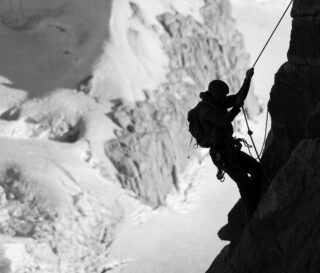
Scale Breaker France
Our comprehensive LHO Matterhorn Course offers an advanced alpine itinerary designed for those seeking to elevate their skills to the next level. This meticulously crafted and flexible program is delivered by our selected IFMGA certified guides with the support of our LHO Team Leaders. It places a strong emphasis on building experience in mixed alpine ascents, with the ultimate goal to climb the Matterhorn and beyond. Whether you're preparing for a guided Matterhorn climb or simply curious about what it takes to tackle this iconic Matterhorn mountain climb, this course offers the ideal foundation to grow your skills, your confidence, and your alpine journey.

TRIP TYPE
Climbing and Mountaineering

DURATION
8 Days

DESTINATION
France
1
An all inclusive advanced alpine mountaineering experience featuring ridge training and alternative routes during adverse weather, at no extra cost.
2
Includes several highly sought-after summits such as the Dent du Géant, Entrèves Traverse, and Perrons Traverse, alongside the iconic Matterhorn.
3
Guided by a specialised LHO Expedition Coordinator and certified IFMGA guides, ensuring a seamless, safe experience, with full support on and off the mountain.






2026
DATE & STATUS
PRICE
TEAM LEADER
AVAILABILITY
WHAT'S INCLUDED IN THIS TRIP
WHAT'S NOT INCLUDED IN THIS TRIP
DAY 1: WELCOME TO EPIC CHAMONIX
The first day of our itinerary is the arrival day. If you’re arriving at Geneva airport, our transfer partners will meet you and take you to our hotel in the Chamonix valley. If you’re meeting us directly at the hotel, your LHO Team Leader will be waiting for you there. Check-in at our accommodation usually begins at 3 pm. If you arrive early, you can store your bags at the hotel and explore the area. Your LHO Team Leader will send you a list of things to do in Chamonix closer to the time. For those of us requiring rental gear, we highly recommend arriving early because the gear stores close at 7 pm, and we generally try to get an early start the following day before shops open. A team dinner and briefing will take place at 7:30 pm, hosted by your Team Leader and lead mountain guide. This will be your first opportunity to meet everyone we’ll be spending the week with, ask questions, and learn about our exciting week ahead. Gear checks will be coordinated by your LHO Team Leader throughout the day based on your arrival times to make sure you have everything you need for our week ahead.
DAY 2: THE PERRONS TRAVERSE
Distance: 7.9 KM | Ascent: 959 M | Descent: 955 M
The first day of this expedition is about getting used to the void, experiencing dry rock on big alpine routes, but also doing so at relatively low altitude because we are not yet acclimatized. After breakfast, you’ll be met by the lead expedition guide and taken by private car across the Swiss border to the nearby Emosson Lake. Your LHO Team Leader will be there to coordinate the transfers and help you prepare your packs for the day prior to departure. The road trip takes about 40 minutes. As we will be crossing the border, it is important that you keep your passport or travel document on you.
Emosson Lake is an artificial lake formed because of the Emosson Dam project. It is a French-Swiss initiative that collects water from the Mont Blanc Massif. From the parking to the start of the climb requires about one hour of trekking, first across the dam and then into the sharp foothills that lead to the towering Perrons ridge above. The beauty of this ridge cannot be overstated. It is flanked by the entire Mont Blanc range on our left, the entire Valais range behind us, and the Emosson Lake to our immediate right.
We’ll gear up with our ropes, harnesses, and helmets at the base of the ridge for the start of the climbing portion of the day. The ridge is broken up into a series of easy scrambles, challenging pitches of grade climbing up to 4C, and several sections of abseiling. This gives us the opportunity to get our first taste of essential skills such as short roping, pitching, and setting up anchors for abseiling. Your guide will give you a thorough explanation of each skill and how to utilize them over the different sections. They form the bedrock of what is needed on mixed alpine-grade climbing and ultimately the Matterhorn.
Completing the Perrons traverse is a major mountaineering achievement in its own right, and although our aim is to complete the entire traverse, we understand that sometimes it may be desirable to exit the traverse at earlier points. Your guide will determine what is the best course of action based on conditions and your energy levels. Once we rejoin the dry trail, we’ll make our way back to the car for the ride to Chamonix where showers and dinner await!
DAY 3: THE INCREDIBLE ENTREVES TRAVERSE
Distance: 5.4 KM | Ascent: 593 M | Descent: 593 M
Our second day together will start early in the morning. After breakfast, we’ll check out from our hotel room, place our luggage in the storage room, and depart from the hotel in the direction of the Mont Blanc tunnel to Courmayeur on the Italian side of the mountain. From there, we’ll take the Skyway cable car to Punta Helbronner, right on the edge of the glacier. This is a spectacular destination in itself, attracting tourists from all over Europe who come to get a closer look at the incredible Mont Blanc region.
Upon arrival, we’ll descend an elevator into the mountain and walk through a tunnel to exit at the Torino Hut, our accommodation for the next two nights. We choose the Torino Hut because of its ease of access, high altitude acclimatization opportunities, and the multiple summits available directly from one mountain refuge. After checking in and having a quick bite, we’ll immediately head out onto the glacier in the direction of the Col d’Entreves.
The trail across the glacier begins in a northbound direction. We’ll cross the natural border back into France before starting a sharp descent between the summits of Petit and Grand Flambeau. The trail begins to veer towards a westerly direction with the summit of La Toule appearing on our left. We’ll continue past and continue descending west. The towering pillars of the east face of the Mont Blanc will be straight ahead of us. At the base of the descending glacier, we’ll begin to climb as the trail starts to turn South back in the direction of Italy.
The Aiguille d’Entreves will now be on our immediate left. We’ll follow the glacier all the way to the base of the ridge on its southwestern side. Where the ridge meets the glacier is known as the Col d’Entreves. It is also the starting point of the normal route to the summit of the Tour Ronde when climbing in the opposite direction. We usually remove our crampons at the base of the ridge, but this depends entirely on conditions. If there is ice on the rocks, it may be desirable to keep them on throughout the traverse.
From the very start of the ascent along the ridge, we will be exposed to the void first on our right side and then gradually on the left side as well. Being exposed to the void is very important because it enables us to get used to being in these environments and obligates us to focus our faculties on the immediate vicinity of our climb and where our hands and feet are rather than the distant happenings around us.
The climb isn’t challenging in terms of vertical gain but requires sure-footedness as we cross the sharp sections and gendarmes that characterize the traverse. The summit itself is quite underwhelming as it is hardly higher than the rest of the ridge, but the climb itself is incredibly impressive. From the summit, we will continue along the ridge, employing several of the techniques we learned on our first day before finally reaching the last abseil. From there, we will each lower ourselves back onto the glacier with assistance. After we all land on the glacier, we will put on our crampons, descend slightly, and rejoin the trail beneath La Toule to climb back up towards Torino Hut. Crossing the glacier can be tricky, especially during warmer summers. It is important to remain vigilant and listen to the instructions of the guide. The evening will be spent at the Torino hut, located at 3300 meters above the Italian town of Courmayeur. It is ideal for acclimatization and is reasonably comfortable, meaning we’ll have plenty of opportunities to rest and recover. Dinner will be at the hut.
DAY 4: ASCENDING THE TOOTH OF THE GIANT
Distance: 5.0 KM | Ascent: 725 M | Descent: 725 M
Our second day at high altitude presents us with the opportunity to climb Dent du Geant (Tooth of the Giant), one of the iconic summits of the Mont Blanc and also a summit above 4000 meters. Dent du Geant is a technically more demanding summit than the Matterhorn, although it is much lower in altitude, and its technical sections are a quarter of the size of the Hornli Ridge.
We do summits such as the Dent du Geant to increase our technical know-how beyond what is necessary for our primary objective, in order for us to be better able to handle the longer and higher summits at a technical grade that we would already have built confidence to overcome. We normally grab breakfast at 3 AM and head out onto the glacier shortly after. We can leave things at the hut since we’ll be returning here before descending back down to Chamonix.
We’ll rejoin the glacier at the same point as the previous day, only this time we will be moving in an eastbound direction directly towards the towering Dent du Geant ahead of us. The glacier trail turns around the Aiguille Marbrees before reaching the Col du Geant and ascending to the couloir that forms the trailhead to the summit of the mountain. Unlike previous summits, we will be climbing on different terrains in addition to ridges.
The first section is a snow couloir that climbs directly beneath the summit above. The couloir can be dangerous during dry periods or when there are multiple climbers overhead due to the rockfall that can funnel directly into it. It is important to listen carefully to instructions and not linger in this area for too long. Once above, we’ll begin a series of easy switchbacks that follow along a combination of rock, soil, and snow trails that weave their way up along the southern flank of the summit until we reach the Salle a Manger. This is a small glacier that sits on a plateau of rocks at the base of the rock climbing section that ascends the tooth to the summit.
We typically take a short break here and give the guide an opportunity to recoil the ropes and prepare for the main technical objective of the climb. We typically do not use crampons to climb the wall. Once ready, we’ll traverse the Salle a Manger to the base of the climbing section. The guide will ascend first and create anchors that we then climb to. There are about 6 pitches of climbing along the normal route. On some very technical sections, there are fixed ropes that can be used to assist. Listening to instructions, maintaining a steady pace, and keeping composure is the key to this climb. The void may be impressive, but we’ve already learned that the void is immaterial to where our concentration should be, which is on our hands and our feet.
Once we reach the small summit, there is a short ridge crossing the real summit of Dent du Geant. As the summit is quite narrow, we will quickly take our pictures and make our way to the abseils so as not to get stuck in a traffic jam. Efficiency at this level of alpinism is very important. There are between 4 to 5 abseils to descend from the Dent du Geant’s summit. The number of abseils used depends on the length of the rope being used. Once safely back at the Salle a Manger, we’ll take a break and have a snack before rejoining the trail back down towards the couloir and onto the glacier.
When rejoining the glacier, especially if it has gone past midday, it is important to efficiently put on the crampons and move away from the couloir to avoid anything that may fall there from climbs above. The warmer it gets, the looser the rocks become. Once we’re all roped up, we will traverse back across the glacier to Torino hut where we’ll have our packed lunches, pick up anything we may have left there, and take the Skyway cable back down to the valley. It’s normally a short ride through the tunnel, although there can sometimes be traffic during the mid-summer months or around holidays. Once back in Chamonix, we’ll check-in to the hotel, shower, and meet up for dinner.
DAY 5: ZERMATT MATTERHORN
Distance: 4.2 KM | Ascent: 744 M | Descent: 38 M
The Matterhorn may not always be possible, and it’s important to recognize this from the outset. A combination of conditions in the mountains and your own physical ability and alpine skills need to prove favorable for us to give it an honest shot. If the Matterhorn is not possible, we’ll attempt another major summit that pushes beyond your limits at your level. Other options include the east ridge of Mon Viso, the Duforspitze, or the Aigulle Verte. Your LHO Team Leader and IFMGA guide will present options closer to the time if needed.
If we determine that the Matterhorn is possible, then we’ll depart by car to Zermatt after breakfast. We’ll be getting an early start so that we have enough time to reach Hornlihutte and rest there. The ride from Chamonix is very scenic. We’ll be heading to the same border we would have crossed for the Perrons traverse, only this time we’ll continue deeper into Switzerland to the opposite side of the Canton Valais. The ride takes about two hours and a half. We’ll be dropped off at the train station in Taesch where we’ll board the Matterhorn train for the 15 minutes ride to the town center. No cars are allowed into Zermatt. That’s why we get dropped off at the closest station to the town.
We’ll leave the sightseeing for the way back and cross the town directly to the cable car station. It takes about fifteen minutes to reach the station on foot. There, your guide will purchase the cable tickets, and we’ll head up to the Schwarzee cable station. It is the closest station to the Matterhorn and the starting point of our trail that ultimately leads to the summit. The trail is an easy walk and incredibly scenic with the Matterhorn towering ahead of us, the Monte Rosa directly behind us, the Mischabel range behind us to our right, and the summits of the Weisshorn-Matterhorn range to our immediate right. It normally takes around three hours to complete.
Once at the hut, we’ll check-in, have dinner, and hear the full briefing for the summit push ahead of us. Although it is desirable to attempt the summit on our first night and sleep at the hut on the way down, we may find that it is only possible to climb on the second night. In that instance, it is important to descend back to the cable station in the same day. LHO is one of the few outfitters that offers two nights at the Honrlihutte as part of our standard itinerary in order to maximize our chances and widen the window of opportunity as much as possible.
DAY 6: THE GREATEST CLIMBING DAY OF YOUR LIFE
Distance: 8.1 KM | Ascent: 1,524 M | Descent: 1,524 M
Most outfitters provide only one window to summit the Matterhorn. We strongly disagree with this way of doing things. That’s why our itinerary includes a second night at the Hörnli Hut. It provides maximum flexibility and the widest possible opportunity to make the climb happen. Spending a second night gives us options with our turnaround time if we choose to climb on the first day. It also gives us the chance to climb on the second night if the first window is not possible.
Because the Hörnli Hut is very comfortable and provides showers, we find that spending a second night is desirable even if the first summit window was achieved and even if we were able to return in good time. Breakfast on the summit night is typically at 3 AM. The Hörnli Hut has particular traditions that are unusual in the Alps. Here, the local Zermatt guide must be the first guide to exit the hut at 3:30 AM. No other guide is allowed to exit the hut until that happens. This creates a bit of a frenzy at the door and a dash to the first ascending section located 50 meters outside the hut. Not to worry. Within 30 minutes, the teams tend to separate, with the faster parties dashing ahead and the slower parties falling behind. Once the pace naturally regulates, the climb starts to become very enjoyable.
During the mid-summer season, the sunrise is quite early. This means that by 4:30 AM, we will already start to see daylight breaking over the Monte Rosa behind us. It also makes the more challenging sections above more visible and easier to navigate. After the initial rocky section, the trail becomes easier with steeper scrambling sections and even sections with switchbacks. These easier sections should be used to gain time by ascending rapidly but also sustainably. The higher we go, the steeper the climb becomes. Our aim is to avoid pitching as much as possible and try our best to short rope as many sections as possible until we reach the Solvay Hut, an emergency refuge located 400 meters beneath the summit.
Reaching Solvay is a milestone and an important one because if we are not at or near the Solvay hut by 7 AM, then it is unlikely we will be able to push on to the summit. The reason for this is exposure length, its effects on our energy levels, and the fact that the most common accidents happen on the way down when energy is low. From the Solvay Hut, the climb becomes more exposed as we approach a series of short climbs to access the shoulder. In recent years, it hasn’t been necessary to wear crampons on the shoulder. Your LHO Guide will let you know if crampons are necessary here; otherwise, we’ll continue without them. The shoulder is impressive because it’s the first time that we are totally exposed on both the North and West faces of the mountain. Once past the shoulder, we will start the final ascent to the summit that is characterized by steep faces and a series of fixed ropes similar to what we would have experienced on the Dent du Géant.
This section is very committing and requires your full focus. At the top of the last rope is the final summit ridge that gradually tops out on the top. There is an Italian summit and a Swiss summit of the Matterhorn. The two are joined by a small ridge. We typically traverse to the Italian summit to complete both. Picture-taking opportunities are limited at the summit. We’ll do our best to spend as much time as possible, but time works against us on the Matterhorn, and the challenging part is on the descent. We’ll trace our steps down the fixed ropes. There, we will abseil along the face until we reach the shoulder. If it is possible to avoid abseiling on easier down-climbing sections, then it is always desirable to avoid wasting time. However, safety dictates the overall strategy throughout.
Upon returning to the Solvay Hut, we’ll have the chance to rest for a short while, drink some water, and have some food. We’ll then continue our descent along the ridge, employing the downclimbing strategies we would have learned throughout the week. Remember that the longer this takes, the longer it’s going to take. Try to avoid looking at how far we still have to descend. Focus only on what is under your immediate control. That is, your feet, hands, and morale. That is the key to finding yourself in the hut faster. Once in the hut, we’ll have the opportunity to shower, sleep, and enjoy our last night meal in the mountains together.
DAY 7: RETURN TO CHAMONIX
Distance: 4.2 KM | Ascent: 38 M | Descent: 744 M
If we aren’t able to ascend the Matterhorn on the previous day, then we’ll be both ascending to the summit and descending to the cable station on the same day. This is the standard practice on the Matterhorn, and having a full day to rest before it means that we should be more than ready for this undertaking. If we were able to ascend on the previous day, then this day is dedicated to returning to Chamonix.
After breakfast, we’ll depart the hut in the direction of the Schwarzee cable station. From there, we’ll hop on our ride to Zermatt. We’ll give ourselves about an hour to roam around and shop for souvenirs in the market streets before hopping on the train to Täsch, where our car will be waiting to take us back to Chamonix. We’ll have our packed lunches in the car during the road trip. Once back in Chamonix, we’ll drop off our rental gear and check-in to our hotel for a shower. We usually arrive in the early afternoon, so there is more than enough time to hit the shops before they close. Your LHO Team Leader will be on hand to provide recommendations and also let you know where and when our farewell dinner will be. The last round of drinks is on us!
DAY 8: AU REVOIR!
Our final day together will be dedicated to airport transfers and farewells. Breakfast is included on the day. Please make sure that you provide us with your correct departure details when filling out your team details form as we use it to book your transfers to Geneva airport with our transfer partners. If there are any changes to your travel itinerary, please let your LHO Team Leader know as early as possible so that arrangements can be made.

OUR COMMITMENT
We are dedicated to ensuring that everyone involved in our services receives a fair living wage in their respective countries. We invest in our team members, fostering upward mobility within the adventure travel industry, expanding educational opportunities, and offering support wherever we can. By joining an LHO adventure you are directly impacting the incredible people and the remote communities that make these life-changing experiences possible.
LEARN MOREHEALTH & SAFETY GUIDELINES
We do our best to ensure your wellbeing on LHO adventures. That's why the facilities we use throughout our trips are required to meet our health and safety standards. We also follow the laws and protocols of every country that hosts our adventures. This extends to national regulations requiring Covid-19 testing, vaccination certificates, mask wearing or any other local guidelines that may apply. Contact us for the most up to date protocols related to your destination.
LEARN MOREHow long does it take to Climb the Matterhorn?
Most climbers attempt the Matterhorn climb via the Swiss normal route, known as the Hörnli Ridge, which is typically done over two days and one night. The first day involves a short three hour trek from the Schwarzsee cable car station to the Hörnlihütte, the mountain hut located at the base of the route. The summit day begins early, around 3:30 am, with climbers aiming to reach the summit and return all the way back down to Zermatt on the same day.
At Life Happens Outdoors, we include two nights at the Hörnlihütte in our itinerary. This gives us flexibility to account for adverse weather, which is common on alpine ascents — even in summer. If conditions are ideal and we only need one summit attempt, the second night allows for a more relaxed descent without the pressure of rushing to catch the last cable car.
How hard is it to climb the Matterhorn?
We consider the Matterhorn climb a Scale Breaker, placing it in the highest category of physical commitment alongside other major alpine ascents. This is not just a mountain — it is a full scale endurance challenge that demands preparation, determination, and skill.
Joiners who want to realistically attempt the Matterhorn should be in peak physical condition, with a strong focus on cardio fitness and endurance. You should also be confident in your technical abilities, especially on both dry and ice covered ridges, as the route involves sustained movement over exposed and demanding terrain.
Climbing the Matterhorn is a bold goal, and reaching the summit is one of the most rewarding achievements in mountaineering.
What is the climbing grade of the Matterhorn on the Swiss Normal Route?
The climbing grade of the Matterhorn on the Swiss normal route, known as the Hörnli Ridge, is AD plus (Assez Difficile plus) on the alpine grading scale. However, it is important to understand that this grade can vary significantly depending on conditions.
If there is snow below the Solvay Hut or ice on the rock known as verglace, the difficulty increases considerably. These factors can make the climb more technical and physically demanding.
Anyone choosing to climb the Matterhorn at this level should have a high level of comfort climbing at AD and D grades, and be prepared to adapt to changing mountain conditions.
What is taught as part of the Mattehorn Course?
The Matterhorn Course focuses on developing your ability to move confidently on challenging ridge routes and tackle easy grade rock climbing while wearing alpine mountaineering boots. It is designed to elevate your skills and prepare you for higher grade alpine ascents.
This course assumes you already have entry level mountaineering knowledge, typically covered in the Mont Blanc Summit Course at Life Happens Outdoors. The purpose here is to upgrade your skills and help you transition from F and PD grade mountaineering to the AD and D grade level, which is required for climbs like the Matterhorn and other advanced objectives.
What summits do we attempt as part of the Matterhorn Course?
We believe in learning by doing. That is why each day of the Matterhorn Course is built around a major alpine objective that also serves as a learning opportunity.
As part of this course, we typically aim to climb the Perrons Traverse, the Entreves Traverse, the Dent du Geant, and finally, the Matterhorn itself. Each of these summits helps build the technical skills, endurance, and confidence needed to take on high level alpine objectives.
Keep in mind that these summits are listed to guide the trajectory of the course, but the actual progression may change based on mountain conditions or the progress of participants. The goal is always to create the most meaningful and effective learning experience possible within the realities of the alpine environment.
Do we climb the Matterhorn as part of the course?
Yes, the Matterhorn climb is included in the course plan as the final objective, but whether it happens depends entirely on two key factors — how well we progress in training and the weather conditions, which are always a major consideration in alpine environments.
That said, it is absolutely possible to climb the Matterhorn within the course. The course is designed to build you up toward this challenge step by step, but summit attempts are always subject to safety, readiness, and the conditions on the mountain at the time.
When is the best time to climb the Matterhorn?
The best time to climb the Matterhorn is between mid July and early August. During this period, there is typically less snow, making the ascent safer, but the conditions are not so dry that the route becomes hazardous due to rock fall.
The key factor to watch is the snow line. If the snow line is below 4000 meters, we typically avoid attempting the Matterhorn climb, as this increases the difficulty and risk. Timing the ascent within the right weather window is essential for both safety and summit success.
What happens if it is not possible to climb the Matterhorn?
If it is not possible to climb the Matterhorn due to weather conditions or readiness, we will simply divert to an equivalent objective or select a summit that matches your current skill level.
Alternative options to the Matterhorn climb include iconic routes such as Mon Viso via the East Ridge or Pointe Inominata — both rewarding and challenging alpine ascents in their own right. Our goal is always to ensure that you finish the course having had a meaningful, high impact climbing experience, even if mountain conditions do not allow for the Matterhorn itself.
Where does Life Happens Outdoors conduct the Matterhorn Course?
Life Happens Outdoors welcomes you to our base in Chamonix, where the Matterhorn Course begins. We head to Zermatt only when the time comes to attempt the Matterhorn climb.
We choose Chamonix because of the incredible flexibility it offers, with road access to France, Italy, and Switzerland. This allows us to adapt the itinerary based on weather conditions, maximizing the time we spend in the mountains and minimizing time lost in transit. This flexibility is especially important in alpine environments, where one region may be affected by poor weather while another remains perfectly climbable.
Chamonix also gives us immediate access to ideal terrain for the ridge courses and training objectives that are fundamental to the development journey of this experience.
What does an all-inclusive Matterhorn Course mean?
An all inclusive Matterhorn Course means that everything outlined in the itinerary is covered, so you can focus entirely on your mountaineering objective without having to reach for your wallet during the trip.
This includes all meals, starting with dinner on arrival night and ending with breakfast on your departure day, as well as all lift passes, transportation fees, airport pick ups and drop offs, pack lunches, diversions to other mountains if needed, and accommodation in mountain huts and hotels.
In short, everything is taken care of so that your undivided attention can stay on the mountains, and we take care of the rest.
PAYMENT PLANS AVAILABLE
FROM £5,720
DOWNLOAD YOUR TRIP GUIDEBOOK
INQUIRE NOW
This adventure is only available as a private trip and is customized to your requirements, experience and skill level. To get started, please fill out the form below. We’ll be in touch soon to put it together for you.
"(Required)" indicates required fields
CONTACT US
We’re passionate about guiding you to epic adventures and beyond. If you have any questions at all, don’t hesitate to reach out. We’d love to hear from you.

